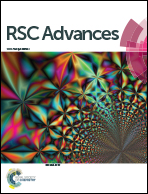Increasing toughness and tensile strength of an epoxy–diamine system using an inorganic ultra-accelerator
Abstract
Epoxy resins are a class of thermoset materials with extensive structural and composite applications. A wide range of chemical species, of which room temperature curing agents are most favourable, due to their widespread applications, can easily cure these resins. The major drawback of low temperature curing agents is their relatively high curing time. To overcome this issue, accelerators are usually added to decrease curing time and temperature. In this study, we present a unique type of inorganic accelerator that has immensely reduced curing time and temperature as well as imparting major improvements in mechanical properties including tensile strength, izod impact strength and adhesion strength. The epoxy resins used in the following study were diglycidyl ether of bisphenol A (DGEBA) and Epikure F 205 (modified isophorone diamine). The curing kinetics of epoxy resin was determined in the presence of inorganic accelerator using FT-IR spectroscopy. Resins were cured with and without inorganic accelerator and the thermal properties were investigated using DSC (differential scanning calorimetry). FT-IR spectroscopy results showed that using 5% inorganic accelerator, forced 99.68% of the epoxy groups to open, while crosslinks were observed after 18 minutes at 25 °C. Results from DSC analysis showed that using 5% inorganic accelerator reduced the initial onset curing temperature from 68.3 °C to −2.4 °C, while significantly improved its mechanical properties in the polymer backbone.


 Please wait while we load your content...
Please wait while we load your content...